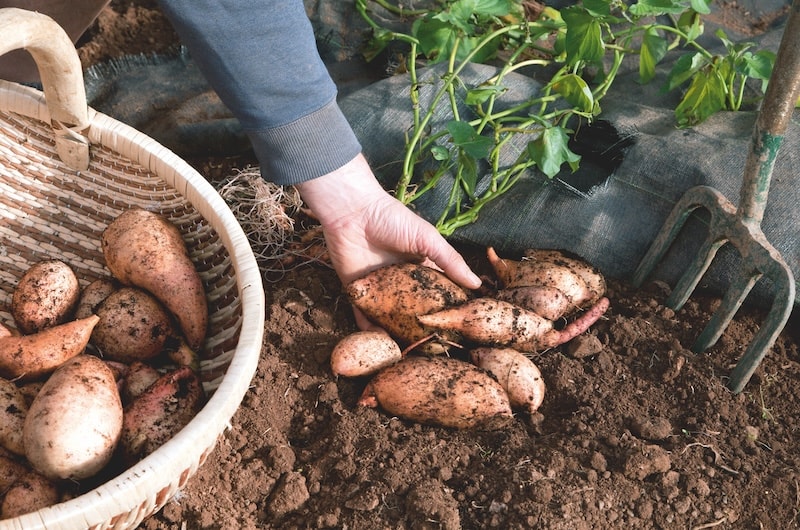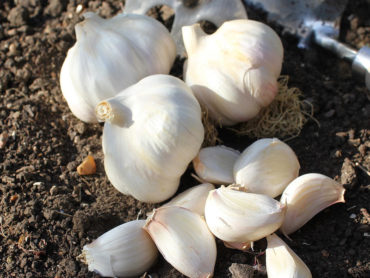Originating from Central and South America, sweet potatoes are large, starchy, sweet-tasting tubers packed with goodness. High in fibre, vitamins and minerals yet low in calories, the sweet potato is an unsung superfood that will happily thrive in the UK climate.
Here, experienced allotment grower Lee Senior generously shares practical tips to help you grow these attractive, nutrient-rich vegetables at home. Browse our full range of sweet potatoes if you’re tempted to have a go.
What is a sweet potato?
Unlike regular potatoes that belong to the nightshade family, sweet potato plants are perennial climbing vines that come from the convolvulaceae family along with morning glory.
They’re traditionally grown from ‘slips’ – tubers that have been cut into large sections and partially immersed in water until they sprout leaves which are then separated and left to root.
However, in a recent propagation breakthrough, Suttons has developed a technique that allows sweet potato plants to be grown from ‘cuttings’. Taken from the young growing shoots of mature sweet potato plants with a sharp knife, cuttings are then moved to carefully regulated warm and humid conditions to produce well-rooted plants that romp away when planted. Here are some of the benefits:
- Earlier production of tubers
- Earlier harvest
- Longer harvest
- Greater yield – produces up to 70% more tubers
- Resistance to disease
- Grows well outside
- Can be grown in pots
What to do when your sweet potato plants arrive
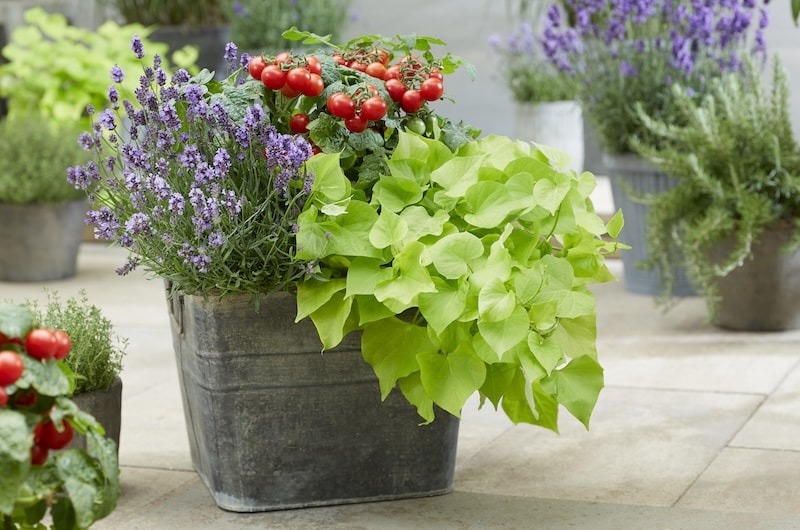
Image: Sweet Potato ‘Makatea’ (Treasure Island Series) from Suttons
Once you receive your new sweet potato plants, it’s important that you give them time to adjust to their new environment. Check the compost is moist and, if required, leave the plants to soak in approx 5mm water for 5-10 minutes, or until the top of the compost is damp.
Stand the plants in a warm, light, airy place such as a windowsill or conservatory and allow them to grow, ensuring that the compost is kept moist. Continue to grow the plants indoors (or in a warm greenhouse) until the roots fill the pots and hold the compost together.
As your plants develop they will need transferring into larger pots to give the roots plenty of room to grow. Once they reach around 30cm in height, you can transfer them to their final growing positions.
Where to plant sweet potatoes
Sweet potatoes are best suited to greenhouse or polytunnel growing (highly recommended for northern regions) but will thrive outdoors in warm summers further south. Ideally add some plant protection like a cloche or fleece, and plant them through black plastic mulch that will suppress weeds and retain the sun’s warmth. The plants don’t do well in cooler exposed conditions, so always try to choose the warmest area that you can.
I find that sweet potatoes grow well with root crops such as beetroot, parsnips and turnips.
How and when to plant sweet potatoes
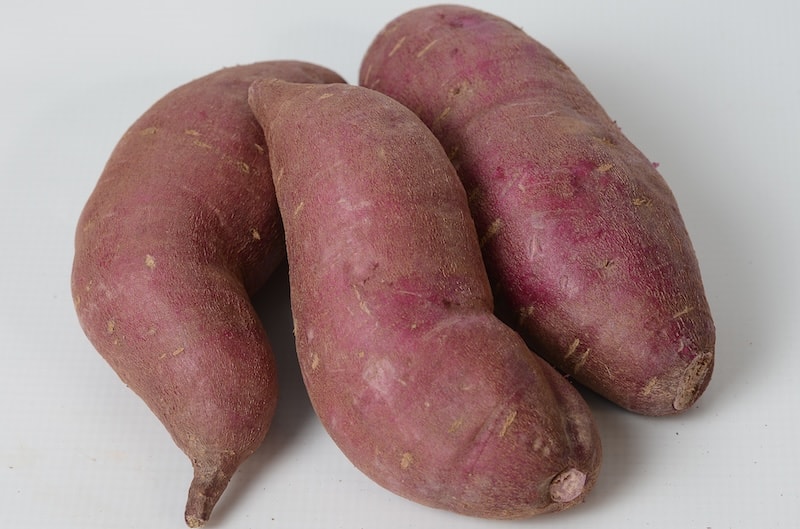
Image: Sweet Potato ‘Tahiti’ (Treasure Island Series) from Suttons
Your sweet potato plants can be started into growth as soon as they arrive during April or May, providing you place them under glass or in a polytunnel and can guarantee gentle heat and frost protection. A windowsill or conservatory is a good place to encourage early growth, as this will also afford the necessary protection from cold.
The plants will be ready to move outside into their permanent positions from late May to June (when all danger of frost has passed) and crop best in temperatures between 15-30°C through the summer.
Plant sweet potatoes 30 cm (12″) apart. They prefer a light sandy soil, as good drainage is important; however they can be planted into ridges 15–30 cm high if your soil is not naturally free-draining. Alternatively, you can plant into patio containers as long as they’re in a sunny, sheltered spot. If plants are to be grown in containers, use a deep pot no smaller than 30 cm (12″) diameter for one plant or 45 cm (18″) diameter for 3 plants.
How to care for sweet potatoes
The good news is that, once planted, sweet potatoes require very little after-care:
- Plants grow vigorously, so water regularly to prevent them from drying out.
- Increase this frequency from August onwards, and then start feeding using a high-potassium plant food.
- Keep an eye out for pests and remove any diseased leaves.
- The tubers usually take about 4-5 months to mature and will be ready to lift in autumn.
How and when to harvest sweet potatoes

Image: Sweet Potato ‘Beauregard Improved’ from Suttons
You can lift your tubers from late September, however, it’s better to leave them until the leaves begin to turn yellow and die back. Be sure to lift them before the first frosts.
Once lifted, your sweet potatoes should be ‘cured’ to set the skins and allow the sweet flavour to develop further. Do this by placing your tubers in trays and keep them somewhere warm and humid (between 25-30°C) to help prevent weight loss during curing. Allow them to cure for 7-10 days and then the tubers can be stored at 10-12°C for up to six months.
Sweet potatoes can be prepared and eaten in the same way as a normal potato, although you may like to try something new. In China the tubers are cut into chunks, fried and then dunked in pans of boiling syrup. In the USA they are served as a candied side dish or turned into sweet potato butter, whereas in Egypt they are simply baked and sold as popular street food.
Best varieties of sweet potato to grow in the UK
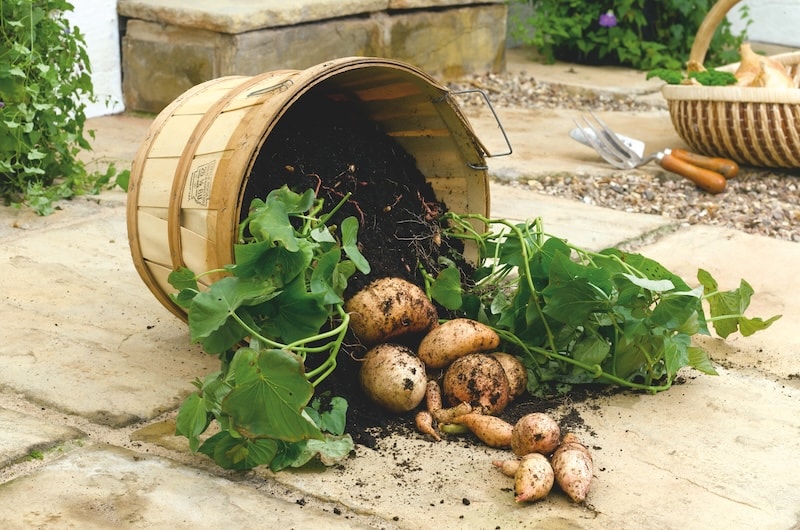
Image: Sweet Potato Mixed Collection (Organic) from Suttons
Some of my favourite sweet potato varieties for UK growing are:
- Sweet Potato ‘Beauregard Improved’ – This is probably the most well-known as it’s often sold in shops and supermarkets. In Louisiana alone they dedicate more than 9,000 acres of land to growing it. The plants produce good crops of medium-sized tubers with sweet, salmon-orange flesh that is high in beta-carotene.
- Sweet potato ‘Tahiti’ – With attractive foliage, this variety makes a fine patio plant. The edible leaves are a tasty addition to salads and the dark purple tubers make a delicious alternative to traditional potatoes.
- Sweet Potato ‘Makatea’ – Producing flavoursome, orange-flushed tubers, this variety is worth growing for its bright green, heart-shaped foliage alone. The edible leaves liven up fresh, homemade salads.
We hope this has given you all the information you need to grow your own nutritious sweet potatoes. Find more of Lee’s practical, hands-on, vegetable growing advice over at his monthly allotment pages.
Lead image: Sweet Potato ‘Beauregard Improved’ from Suttons

